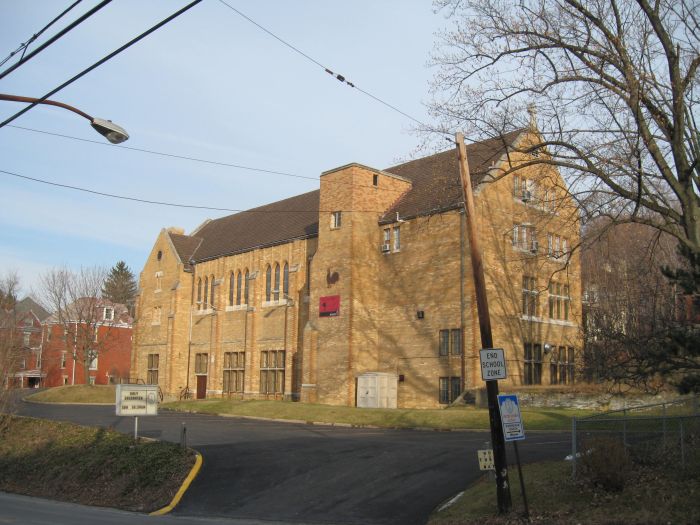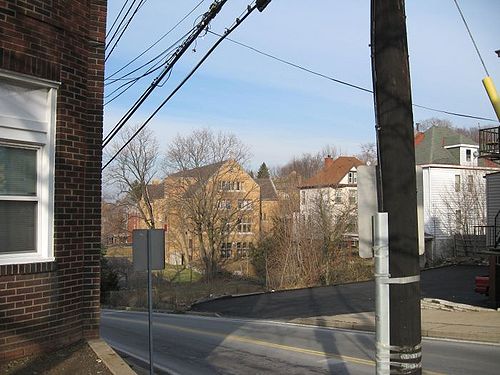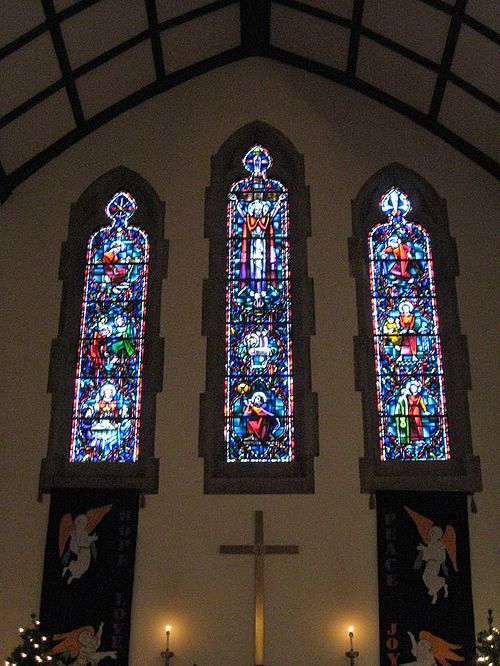Difference between revisions of "Birmingham United Church of Christ"
| (One intermediate revision by the same user not shown) | |||
| Line 1: | Line 1: | ||
| − | [[File:Rooster church 1.jpg| | + | [[File:Rooster church 1.jpg|700px]] |
== Birmingham Church of Christ is also fondly known to local Carrick residents as "The Rooster Church" because of the large Rooster symbol on the side of the church. == | == Birmingham Church of Christ is also fondly known to local Carrick residents as "The Rooster Church" because of the large Rooster symbol on the side of the church. == | ||
| − | + | From the [[Advent Historic Church Walk]] Booklet | |
| − | + | '''BIRMINGHAM UNITED CHURCH OF CHRIST''' | |
| + | 25 Carrick Ave | ||
| − | + | Pittsburgh, PA 15210 | |
| + | |||
| + | Phone: 412-881-6282 | ||
| + | |||
| + | birmingham_ucc@verizon.net | ||
| + | |||
| + | People often say, "If only these walls could speak, what stories they might tell!" Our present church building is certainly no exception, and its history, combined with the history of the two buildings preceding it is a fascinating ac¬count of the faith, hope and love of an interesting, vital and living group of people--the congregation of the Birmingham United Church of Christ. | ||
| + | |||
| + | EARLY HISTORY | ||
| + | |||
| + | In the early 1800s, a group of people originally from Germany settled in the area of South Side known as the Borough of Birmingham. Since there was no German speaking Evangelical Church in their own area, they traveled to the Evangelical Church on Smithfield Street, Downtown Pittsburgh. | ||
| + | |||
| + | As more and more Germans moved to the Borough of Birmingham, they began to realize the practicality of having their own church in their own area, one which would answer their spiritual needs and also house a German school. It was their desire that their children be educated in the German language, both for continued use of German in worship and that they retain an appreciation for the beautiful customs and heritage of their forefathers. | ||
| + | |||
| + | On January 5, 1846, a group of men representing the congregation met for the first time. The name they chose for their church was The German United Evangelical Congregation of the Borough of- Birmingham. They received their official charter on June 27, 1846. The first worship services of the Birmingham Church were held at the Presbyterian Church, formerly located on Fourteenth Street. | ||
| + | |||
| + | The first pastor of the church was the Reverend Hohann Christopf Jehle, who served from 1846 to 1849. Space does not permit a complete account of all of the ministers who served the Birmingham Church., but among the most notable was Reverend Philipp Jakob Zimmermann, for whom our present cemetery was named. | ||
| + | |||
| + | Reverend Zimmermann had been educated and ordained in Germany. Due to his zealous work for liberty in his native Baden, he was sentenced to a life-long term in prison. After serving a short portion of this term, he was given the op¬tion of continuing his prison sentence or spending the rest of his life in exile. | ||
| + | |||
| + | He came to America and was for a time Pastor of the Smithfield Church, before accepting a call to come to Birmingham, where he preached in their first building, located on Tenth and Bradford Streets. At the time they built their first building, the young and growing congregation was able to also purchase one-half acre of land on Brownsville Road; this was the first cemetery. | ||
| + | |||
| + | In 1862 the ladies of the congregation formed the so-called "Frauen Unterstuetzungs Verein," or Ladies Auxilliary Society. Three years later, the congregation decided to purchase 'a building site for a new church building, which would be larger and better equipped to serve their needs. On August 9, 1866 the cornerstone was laid, and in the year 1867 they dedicated the new building and purchased a parsonage at the corner of Seventeenth and Jane Streets. | ||
| + | |||
| + | On October 49, 1913 Reverend Otto Eisele became pastor of the Birmingham Church, and he was the first pastor to begin instituting worship services in English. Up until that time all worship services were conducted entirely in German, but with the decline of the German School, many of the young people could no longer understand German well enough to worship entirely-in that language. | ||
| + | |||
| + | At first, English services were held on Sunday even¬ings, but in time there were two morning services, the first of which was¬ German, followed.,, by English, Under Reverend Eisele 's leadership the Lincoln Bible Class (so named because the first meeting of this class took place on - President Lincoln's birthday, and because the congregation valued Lincoln's ideals of .freedom of thought and speech, which so well reflected their own feelings), the Friendship Bible Class, the Cradle Roll and the Sewing Circle came into being. | ||
| + | |||
| + | The year, of 1924 was another, important one for the Birmingham Church. After much discussion and prayer, the congregation voted to become af¬filiated with the General Council of Congregational Churches. They felt that in so doing they would not be giving up their ideals of freedom and in¬dependence, but instead would be joining with others who shared these same ideals and who could offer assistance and suggestions for growth. | ||
| + | |||
| + | In 1926 the Birmingham Brotherhood was founded. In the same year the church celebrated its eightieth anniversary. Reverend Eisele compiled and published a bilingual book with many photographs for this event which was a further milestone in the life of the congregation. | ||
| + | |||
| + | During the years following, several crucial decisions had to be addressed by the congregation; these decisions were to be of great significance to the con¬gregation then and now. In the year 1937 a new pipe organ was purchased and installed. In 1943, July 18, the congregation voted to start a building fund campaign. The present building site was purchased in 1945, and in 1946 they sold a building site that they had previously purchased on Ormsby Avenue. | ||
| + | |||
| + | HISTORY OF THE PRESENT CHURCH BUILDING | ||
| + | |||
| + | Our present church building was designed by architect Harvey A. Schwab. The contractor was Henry Busse. On February 25, 1951, the congregation dedicated their new church building. Built in the Gothic style, the church proper is of the chancel type, with a center aisle and two side aisles. Especially noteworthy are the beautiful marble altar, the many stained-glass windows depicting scenes from the life of our Lord, Jesus Christ, the high ceiling with its partially exposed beams reminiscent of many of the buildings in Germany, and the wooden pulpit, slightly elevated, from which the true gospel is still preached every week. | ||
| + | |||
| + | In 1957, the Congregational Christian Churches voted to align themselves with the Evangelical and Reformed Churches, and the Birmingham Congregational Church voted to become part of this new denomination in the year 1964, a decision that is both in keeping with the Evangelical origins of the church and the desire for freedom that was behind the decision to join with the Congregational Churches back in the year 1924. | ||
| + | |||
| + | Since that time, the Birmingham Congregational Church carries the name Birmingham United Church of Christ, name that reflects the rich and varied heritage of our church and also points to Jesus Christ, our Lord. | ||
| + | |||
| + | The Birmingham Church is still a church with a vital, living ministry. The best testimonial of the church as a whole comes in the form of the com¬ments that our visitors make. Many have said and continue to say that the- Birmingham United Church of Christ is one of the most caring and friendliest churches they have attended. | ||
| + | |||
| + | Birmingham United Church of Christ: One-Hundred and sixty-five years young, years of Faith, Hope, and in all things Love. May we all remember with pride the accomplishments of our founders, may we work to do the will of God in all things, and may we look forward to the future with the same optimism and renewed vigor that our founding members had long ago. | ||
| + | |||
| + | == This is a view from Becks Run Road and is actually the rear of the church. The church's main entrance is on 25 Carrick Avenue, the site of the former 4th location of the [[Concord Elementary School]]. == | ||
| − | [[File: | + | [[File:Rooster church.jpg|500px]] |
| + | |||
| + | [[File:Birmingham United 2.jpg|500px]] | ||
| + | [[File:Birmingham United 1.jpg|500px]] | ||
== The inside of the church. == | == The inside of the church. == | ||
| − | [[File: | + | == The Windows of the Church == |
| + | [[File:Ucoc church window 4.jpg|500px]] [[File:Ucoc church window2.jpg|500px]] | ||
Latest revision as of 18:03, 26 December 2011
Contents
- 1 Birmingham Church of Christ is also fondly known to local Carrick residents as "The Rooster Church" because of the large Rooster symbol on the side of the church.
- 2 This is a view from Becks Run Road and is actually the rear of the church. The church's main entrance is on 25 Carrick Avenue, the site of the former 4th location of the Concord Elementary School.
- 3 The inside of the church.
- 4 The Windows of the Church
Birmingham Church of Christ is also fondly known to local Carrick residents as "The Rooster Church" because of the large Rooster symbol on the side of the church.
From the Advent Historic Church Walk Booklet
BIRMINGHAM UNITED CHURCH OF CHRIST
25 Carrick Ave
Pittsburgh, PA 15210
Phone: 412-881-6282
birmingham_ucc@verizon.net
People often say, "If only these walls could speak, what stories they might tell!" Our present church building is certainly no exception, and its history, combined with the history of the two buildings preceding it is a fascinating ac¬count of the faith, hope and love of an interesting, vital and living group of people--the congregation of the Birmingham United Church of Christ.
EARLY HISTORY
In the early 1800s, a group of people originally from Germany settled in the area of South Side known as the Borough of Birmingham. Since there was no German speaking Evangelical Church in their own area, they traveled to the Evangelical Church on Smithfield Street, Downtown Pittsburgh.
As more and more Germans moved to the Borough of Birmingham, they began to realize the practicality of having their own church in their own area, one which would answer their spiritual needs and also house a German school. It was their desire that their children be educated in the German language, both for continued use of German in worship and that they retain an appreciation for the beautiful customs and heritage of their forefathers.
On January 5, 1846, a group of men representing the congregation met for the first time. The name they chose for their church was The German United Evangelical Congregation of the Borough of- Birmingham. They received their official charter on June 27, 1846. The first worship services of the Birmingham Church were held at the Presbyterian Church, formerly located on Fourteenth Street.
The first pastor of the church was the Reverend Hohann Christopf Jehle, who served from 1846 to 1849. Space does not permit a complete account of all of the ministers who served the Birmingham Church., but among the most notable was Reverend Philipp Jakob Zimmermann, for whom our present cemetery was named.
Reverend Zimmermann had been educated and ordained in Germany. Due to his zealous work for liberty in his native Baden, he was sentenced to a life-long term in prison. After serving a short portion of this term, he was given the op¬tion of continuing his prison sentence or spending the rest of his life in exile.
He came to America and was for a time Pastor of the Smithfield Church, before accepting a call to come to Birmingham, where he preached in their first building, located on Tenth and Bradford Streets. At the time they built their first building, the young and growing congregation was able to also purchase one-half acre of land on Brownsville Road; this was the first cemetery.
In 1862 the ladies of the congregation formed the so-called "Frauen Unterstuetzungs Verein," or Ladies Auxilliary Society. Three years later, the congregation decided to purchase 'a building site for a new church building, which would be larger and better equipped to serve their needs. On August 9, 1866 the cornerstone was laid, and in the year 1867 they dedicated the new building and purchased a parsonage at the corner of Seventeenth and Jane Streets.
On October 49, 1913 Reverend Otto Eisele became pastor of the Birmingham Church, and he was the first pastor to begin instituting worship services in English. Up until that time all worship services were conducted entirely in German, but with the decline of the German School, many of the young people could no longer understand German well enough to worship entirely-in that language.
At first, English services were held on Sunday even¬ings, but in time there were two morning services, the first of which was¬ German, followed.,, by English, Under Reverend Eisele 's leadership the Lincoln Bible Class (so named because the first meeting of this class took place on - President Lincoln's birthday, and because the congregation valued Lincoln's ideals of .freedom of thought and speech, which so well reflected their own feelings), the Friendship Bible Class, the Cradle Roll and the Sewing Circle came into being.
The year, of 1924 was another, important one for the Birmingham Church. After much discussion and prayer, the congregation voted to become af¬filiated with the General Council of Congregational Churches. They felt that in so doing they would not be giving up their ideals of freedom and in¬dependence, but instead would be joining with others who shared these same ideals and who could offer assistance and suggestions for growth.
In 1926 the Birmingham Brotherhood was founded. In the same year the church celebrated its eightieth anniversary. Reverend Eisele compiled and published a bilingual book with many photographs for this event which was a further milestone in the life of the congregation.
During the years following, several crucial decisions had to be addressed by the congregation; these decisions were to be of great significance to the con¬gregation then and now. In the year 1937 a new pipe organ was purchased and installed. In 1943, July 18, the congregation voted to start a building fund campaign. The present building site was purchased in 1945, and in 1946 they sold a building site that they had previously purchased on Ormsby Avenue.
HISTORY OF THE PRESENT CHURCH BUILDING
Our present church building was designed by architect Harvey A. Schwab. The contractor was Henry Busse. On February 25, 1951, the congregation dedicated their new church building. Built in the Gothic style, the church proper is of the chancel type, with a center aisle and two side aisles. Especially noteworthy are the beautiful marble altar, the many stained-glass windows depicting scenes from the life of our Lord, Jesus Christ, the high ceiling with its partially exposed beams reminiscent of many of the buildings in Germany, and the wooden pulpit, slightly elevated, from which the true gospel is still preached every week.
In 1957, the Congregational Christian Churches voted to align themselves with the Evangelical and Reformed Churches, and the Birmingham Congregational Church voted to become part of this new denomination in the year 1964, a decision that is both in keeping with the Evangelical origins of the church and the desire for freedom that was behind the decision to join with the Congregational Churches back in the year 1924.
Since that time, the Birmingham Congregational Church carries the name Birmingham United Church of Christ, name that reflects the rich and varied heritage of our church and also points to Jesus Christ, our Lord.
The Birmingham Church is still a church with a vital, living ministry. The best testimonial of the church as a whole comes in the form of the com¬ments that our visitors make. Many have said and continue to say that the- Birmingham United Church of Christ is one of the most caring and friendliest churches they have attended.
Birmingham United Church of Christ: One-Hundred and sixty-five years young, years of Faith, Hope, and in all things Love. May we all remember with pride the accomplishments of our founders, may we work to do the will of God in all things, and may we look forward to the future with the same optimism and renewed vigor that our founding members had long ago.





